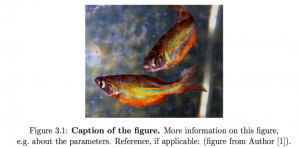4.4 Figures and Tables
Course subject(s)
4. Reporting your findings
Figures and Tables
On this page, we will discuss the use of figures and tables in your report. They can be of significant help in convincing your readers, since they can convey information in a different way. In particular, they are not just meant to brighten up the pages of your report. They can form a part of your argumentation.
We can therefore distinguish two types of figures (or tables): those that serve as part of your argumentation, and those that are not truly a part of your reasoning. The first type of figure is an integral part of your report and strengthens it. The second type of figure does not really belong in a scientific report, except perhaps on its title page.
Tables and figures in your main text

When including a figure or table as part of your argument, it is not sufficient to just drop the figure between the text. The following conventions integrate it into your report:
- The figure/table has a number, so you can refer to it.
- The figure or table has an informative caption; the goal of this caption is to point the reader towards the relevant information in this image. This is particularly useful to readers who look at the figures before reading the main text.
Note: a caption is a sentence, so use appropriate punctuation. - Right behind the caption, some extra information about the picture may be provided. This may cover the choice of parameters, or give a reference.
- If you did not create this table or figure yourself, its inclusion in your report is a citation. Therefore, it needs a reference to allow your readers to look up your source. This source should be included in your reference list.
- If you created the figure on your own, ensure that all information needed to create this figure is included in your report. Your readers should be able to replicate your work.
- The figure / table should be described in the main text body of the report, to show how it fits into your argumentation. The main text body should always be able to stand on its own (it should be understandable without the figure).
- The figure / table is comprehensible: A graph needs labeled axes. It should be clear what function(s) or variables are plotted (perhaps in a legend). It should be clear what the values in a table represent, and any text in a figure or table should be legible. Do not use yellow or light green for curves: their contrast is too low on a white background.
The function of a figure or table
Whenever you include a figure or table in your report, think well on what you want it to show and what role it plays in your argument. Make sure your figure is adapted to its function. Think carefully what type of graph (tables, diagrams, scatter graphs, line graphs, ..) best conveys your information. Some examples:
- To compare the graphs of two functions, plot them in a single figure rather than in two separate ones.
- If you are interested in a certain detail, zoom in to make this detail the focus of your picture.
- To study the exact values of a function at certain points, a table is often more useful than a graph.
Bear in mind that a cluttered picture is often hard to interpret. Too many graphs in one plot become a blur, and very long tables are not an effective way to convey information as part of an argument. When your figure or table contains too many elements, it might be better to split it into several figures/tables that each have their own purpose.
Using figures or tables created by someone else
A figure or table that conveys information is part of your argumentation. If this figure was created by somebody else, you should acknowledge this and give a reference: you are citing this figure. Your readers can then look up the source of your figure in your reference list.
If the figure serves only as an illustration, it is less important to your readers to explain where it came from. After all, it is not truly relevant to your report.
However, beware of copyright rules when using figures created by someone else! As is the case with written text, citations are generally allowed. But for other uses (such as illustrations), you should find out what license the figure was published under and stick to the rules of this license.
When in doubt, you can search for images that are free to use for any purpose (using pixabay, for example). If such a figure is not part of your argumentation, you do not need to give a reference at all.
Figures on your title page
While the figures in your main text body should be a functional, you have more freedom on your title page. Many title pages contain a figure just to illustrate the topic of the report. In contrast to figures in the main text body, this figure does not need a caption or a figure number. On the other hand, feel free to add a caption if you need it to satisfy copyright rules.
On the next page you can pose questions you might have about argumentation, wording, references figures and tables.

Mathematical Modeling Basics by TU Delft OpenCourseWare is licensed under a Creative Commons Attribution-NonCommercial-ShareAlike 4.0 International License.
Based on a work at https://online-learning.tudelft.nl/courses/mathematical-modeling-basics/.



